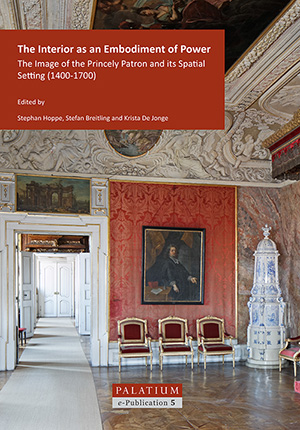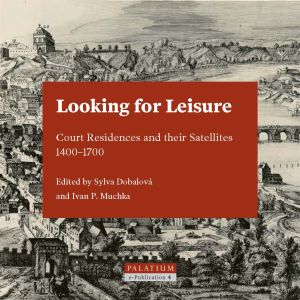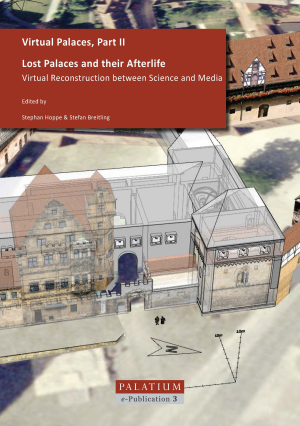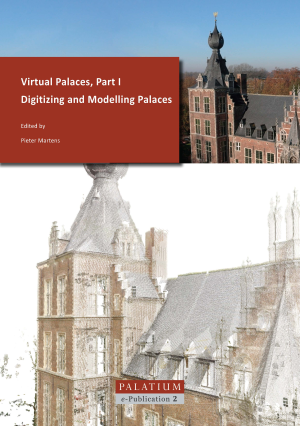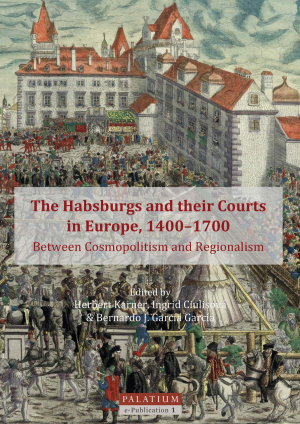PALATIUM e-Publications
Since 2010, the PALATIUM network has created a common forum for research on the late medieval and early modern European court residence or palace (palatium) in a multi- and trans-disciplinary perspective, establishing the cross-European relationships and perspectives which had hitherto only been partially addressed by individual research teams.
Each meeting has offered an original contribution to the study of the art and architecture of the world of courts and their interaction with the rules regulating court life (or ceremonial) in a broad multi-disciplinary perspective; new perspectives on the international exchanges between the different court residences in late medieval and early modern Europe have emerged and are still emerging, involving not only the better-studied networks such as the Habsburg or Valois courts but also the so-called courts at the “periphery”. PALATIUM has managed to interest not only the historian of architecture and of art, but also practitioners of various other disciplines, such as archaeology, political and social history, literature, theatre, music, and heritage studies, and has also significantly contributed to the debate on method in the field in an interdisciplinary perspective.
From November 2010 until March 2015, PALATIUM organized twenty-two events, including six colloquia and six methodological workshops, two thematic conferences apart from the final one (synthesis), three summer schools and a master class, as well as sessions at the Washington RSA annual meeting and at the Brussels and Turin EAHN meetings.
The PALATIUM community now extends beyond the 600 members who receive its Newsletters, and who showed their interest in other ways, thanks to good connections with other institutions and programmes active in the broader field of court studies. Among these, the heritage institutions which aided PALATIUM in various ways, by facilitating visits, seminars or whole events to be held on the premises of the residences they take care of, and by making participants aware of the difficulties involved in preserving this heritage, deserve to be mentioned especially.
Major results of these exchanges are available as e-Publications in open access on the PALATIUM website and here on arthistoricum.net. PALATIUM hopes that these tangible results will generate a continuing interest in the subject, enduring beyond the end of the programme.
![]()
Kontakt
Professor Dr. Krista De Jonge (Chair)
University of Leuven
Department of Architecture, Urbanism and Planning
Kasteelpark Arenberg 1
B-3001 Heverlee
Belgium
Tel: +32 1 632 1379 or 61
Fax: +32 1 632 1984
E-Mail: krista.dejonge@asro.kuleuven.be
Prof. Dr. Stephan Hoppe
Ludwig-Maximilians-Universität München
Institut für Kunstgeschichte
Zentnerstr. 31
D-80798 München
Germany
Tel: +49 0 89 2180 6226
E-Mail: email@stephan-hoppe.de
Bisher erschienen
The Interior as an Embodiment of Power: The Image of the Princely Patron and its Spatial Setting (1400-1700)
This volume is dedicated to the study of the in- and outside of princely residences and of their setup as the stage for a developing European early modern court culture. At a time of increasing aristocratization (1400-1700) and with many new nascent princely courts, both the princely person and the performance of princely power required an appropriate type of elaborate backdrop as its setting. Even though such an interest in the palace interior and its functions is not entirely new, interior architecture and court culture have only recently come to be seen as two sides of the same medal: embodiment and expression of the princely presence.
Therefore, the essays included focus in particular on diverse types of functions that palaces and apartments, state rooms and privy chambers had to fulfil at certain periods and in certain residential contexts between the ages of feudalism and absolutism at courts in London, Edinburgh, Neuburg am Inn, Karlstein and Prague, Červený Kameň and Ludwigsburg. They compare and contrast specific local examples with international trends such as, for example, the palace and court ceremonial developed at or adapted to diverse circumstances in Burgundy, Spain or Lithuania. Consequently, the aim of this volume consists of the combination of personal and dynastic ambitions with fashionable trends and court etiquette followed by royalty and minor princes alike during a period of calculated magnificence. It considers processional routes towards the presence of the ruler or towards its image. Thereby, it helps to define the complementary roles of residential interiors and of the courtly personnel at the same time.
The ten papers collected in this volume were first presented at the PALATIUM colloquium The Interior as an Embodiment of Power―The Image of the Prince and its Spatial Setting (1400–1700), organized by Stephan Hoppe, Krista De Jonge and Stefan Breitling and held in Bamberg in October 2013.
Looking for Leisure: Court Residences and their Satellites 1400–1700
This volume focuses on the leisure buildings – often called casino, palazotto or Lusthaus – which formed an integral part of princely residential complexes in Europe in the period 1400–1700. The aim of this collection is to study these satellite buildings as counterparts to the main palaces. The relatively small size of these structures belies their importance. They took on representative roles and developed certain ideological programmes that would have been difficult to achieve in the larger residential buildings.
Many of these buildings were meant only for seasonal use. Their primary role was as a place of rest, leisure and repose. This relaxation could either take a contemplative form or could include such vigorous activities as hunting, sports and various court festivities. The case studies presented here illustrate the shared principles of these recreational buildings and investigate how their architects and patrons attempted to realize a ‘paradise on earth’ and managed to bring the human world into harmony with the natural world.
Discussing examples from all over Europe – from Central Europe via Italy and France to Denmark and Scotland – the seventeen papers gathered in this volume address four different aspects of ‘palazotto culture’: the terminology that was used to identify these small palaces, which reflects the wide variety of needs they fulfilled; the functions and typologies of these buildings; their artistic decorations; and their gardens and natural surroundings.
Virtual Palaces, Part II: Lost Palaces and their Afterlife. Virtual Reconstruction between Science and Media
Der Band befasst sich mit der digitalen Rekonstruktion und Visualisierung von Schlössern, Burgen und Residenzarchitektur der Frühen Neuzeit. Das Hauptaugenmerk liegt dabei weniger darauf, digitale Modelle von noch bestehenden Gebäuden zu erstellen als vielmehr auf der virtuellen Rekonstruktion „verlorener“ Bauten, besonders bezogen auf Schlösser, die zerstört, stark umgebaut oder auch nie errichtet wurden.
Die 13 Aufsätze des Bandes wurden zuerst anlässlich des Palatium Workshops "Virtual Palaces, Part II" präsentiert, der im April 2012 in München stattfand.
Virtual Palaces, Part I: Digitizing and Modelling Palaces
Dieser Band befasst sich mit den Möglichkeiten virtueller Modelle für die wissenschaftliche Erforschung historischer Orte und Plätze. Das Aufkommen digitaler Messtechniken und Entwicklungen im Modellbau haben die Art und Weise revolutioniert, in der historische Gebäude wie bspw. Residenzen untersucht werden können. Die neuen Techniken bieten noch nie da gewesene Möglichkeiten für Architekturhistoriker, führen aber auch zu neuen Herausforderungen.
Eine dieser Herausforderungen betrifft die Zuverlässigkeit und Nachprüfbarkeit der Daten, die für die Erstellung der Modelle – sowohl bestehender als auch rekonstruierter Bauten - verwendet werden. Auch die Verwendung virtueller Gebäude als eigentliche „Werkzeuge“ für die Forschung, die dabei helfen sollen, Hypothesen über Bauphasen oder zur zeremoniellen Verwendung von Räumen zu visualisieren und zu erläutern, birgt nicht selten Probleme.
The Habsburgs and their Courts in Europe, 1400–1700: Between Cosmopolitism and Regionalism
Dieser Band untersucht Architektur und Kultur an verschiedenen Höfen einer der wichtigsten Königsdynastien Europas, der Habsburger. Er sucht nach der spezifisch Habsburgischen Ausdrucksweise im Bereich fürstlicher Repräsentation an den Höfen von Madrid, Brüssel, Wien, Prag, Bratislava und Budapest. Überstaatliche Charakteristika der dynastischen Identität werden den regionalen Repräsentationen gegenübergestellt.
Kern der fürstlichen Repräsentation war die Hofresidenz. Infolgedessen werden die offiziellen Räume der Habsburger bezogen auf ihre Bedeutung im Hofzeremoniell in den Schlössern in Brüssel, Madrid und Zentraleuropa untersucht, um zu erkennen, ob es ein vereinendes Modell gab. Diese von den Habsburgern entwickelte, übernationale dynastiche Identität wird dann mit lokalen Identifikationsformen verglichen, wie sie beim Adel in Böhmen, Ungarn und Polen anzutreffen sind. Dies zeigt wie die Schlösser und ihre Ausschmückung auch die Loyalität zu den Traditionen des Heimatlandes, den sogenannten Landespatriotismus, ausdrückten.



